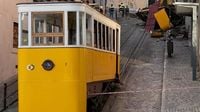Lisbon is a city known for its steep hills, winding cobblestone streets, and the iconic yellow funiculars that have ferried locals and tourists alike for generations. But on Wednesday, September 3, 2025, the city was gripped by a tragedy that has left families mourning across the globe and a nation demanding answers. A catastrophic crash involving one of Lisbon’s beloved Gloria funiculars killed 16 people—including three Britons—and injured more than 20 others, shattering the sense of safety and nostalgia these historic railways once inspired.
The accident unfolded just after 6:00 p.m. local time, as the Gloria funicular was making its usual three-minute journey up the steep incline between Restauradores Square and the Bairro Alto neighborhood. According to eyewitness accounts reported by Sky News and BBC, the packed carriage began to roll backward only moments after starting its climb. Panic erupted as passengers realized something was terribly wrong. Some, seeing another carriage hurtling toward them, leapt from the windows in a desperate bid for survival. Within seconds, the funicular derailed at a bend and crashed into a building 30 meters from the base of the hill, leaving the carriage crumpled and twisted against the stone façade.
The aftermath was harrowing. Emergency responders rushed to the scene, pulling survivors from the wreckage—including a three-year-old German boy, whose miraculous rescue became a rare glimmer of hope amid the devastation. His mother, however, was among those critically injured. Initial confusion over the fate of the boy’s father added to the heartbreak: local media had reported the German man’s death, but, as The Independent later confirmed, he was found alive—though in a very bad state—after his family recognized him in São José hospital. A DNA test ultimately clarified the mix-up, revealing that another man had been mistakenly identified as the German victim. The German Foreign Ministry later stated, “As far as the Federal Foreign Office is aware, there are currently no German citizens among the fatalities.”
The full toll of the tragedy soon became clear. Among the 16 dead were five Portuguese citizens—including four charity workers from Santa Casa da Misericórdia who regularly used the funicular for their commute—along with three Britons, two Canadians, two South Koreans, one American, one French citizen, one Swiss, and one Ukrainian, as detailed by both BBC and Arab News. The British victims were named as Kayleigh Smith, 36, and William Nelson, 44, a couple deeply involved in the UK’s theatre community. Smith, an award-winning director and actress, was remembered by MADS Theatre in Macclesfield as a “valued member of our society” who would be “greatly missed.” The third British victim’s identity had not yet been confirmed as of Saturday. The funicular’s brakeman, Andre Jorge Gonçalves Marques, was also among the dead, with his employer, Carris, hailing him as an “outstanding representative” whose “courage and professionalism, recognised by all, came to a tragic end.”
The injured included at least 11 foreigners—Germans, Spaniards, a Frenchwoman, an Italian, a Swiss national, a Canadian, a South Korean, a Moroccan, and a Cape Verdean, according to emergency services cited by Arab News. The chaos and trauma of the crash were vividly described by tour guide Mariana Figueiredo, who told the BBC she arrived at the site within seconds: “People started to jump from the windows inside the funicular at the bottom of the hill. Then I saw another one [further up] that was already crushed… When I got there the only thing I could hear was silence.” She and others worked desperately to help the injured and calm those in shock.
As the dust settled, questions swirled about how such a disaster could have happened on a line that has operated since 1885 and been electrified for over a century. The Gloria funicular’s two carriages are linked by a steel cable, with one ascending as the other descends—a system designed for safety and efficiency. Theories about the cause of the crash ranged from a snapped steel cable to brake failure. Witnesses and survivors recounted the carriage speeding out of control, while speculation in local media pointed to possible ruptured security cables or maintenance issues overseen by Carris. Yet, officials insisted the system had passed its daily half-hour visual inspection on the morning of the accident and had undergone a full maintenance overhaul the previous year.
Authorities moved quickly to suspend all three other funicular lines in Lisbon pending thorough inspections. Pedro Gonçalo de Brito Aleixo Bogas, head of Carris, announced an independent investigation and pledged that the Gloria line would eventually reopen with a new carriage. He noted that maintenance spending for the funiculars had more than doubled over the past decade, and that the system had operated correctly since at least 2007.
The initial findings report, originally scheduled for release on Friday, September 5, was delayed until Saturday, as confirmed by the GPIAAF air and rail accident investigations bureau in statements to Lusa news agency and Arab News. The report is expected to offer only preliminary insights, with a more detailed technical analysis due within 45 days. Chief police investigator Nelson Oliveira told reporters that no potential cause was being ruled out at this stage.
The tragedy has reverberated far beyond Portugal’s borders. Prime Minister Luis Montenegro called it “one of the biggest tragedies of our recent past,” while British Prime Minister Sir Keir Starmer expressed his condolences, saying he was “deeply saddened” to learn of the British fatalities and that the UK “stands united with Portugal during this difficult time.” A somber service was held at the Church of St Dominic in Lisbon, attended by political leaders, locals, and grieving families, with many calling for a thorough investigation to restore trust in the city’s public transport.
For those who survived, the psychological scars remain. One man, who was in another funicular at the bottom of the hill during the crash, told the BBC, “No matter how many more years I live, I’ll never take the funicular again.” Visitors who had narrowly missed boarding the ill-fated carriage reflected on the randomness of fate, with one Singaporean tourist remarking, “It changes your perspective on life. You just don’t expect something like this to happen.”
Lisbon’s funiculars have long been more than mere transport—they are a symbol of the city’s resilience and charm. As the investigation unfolds and the community mourns, the hope is that answers will come swiftly and that such a tragedy will never be repeated.





